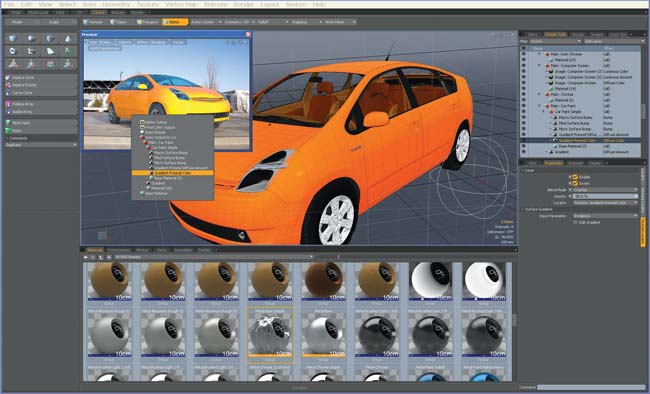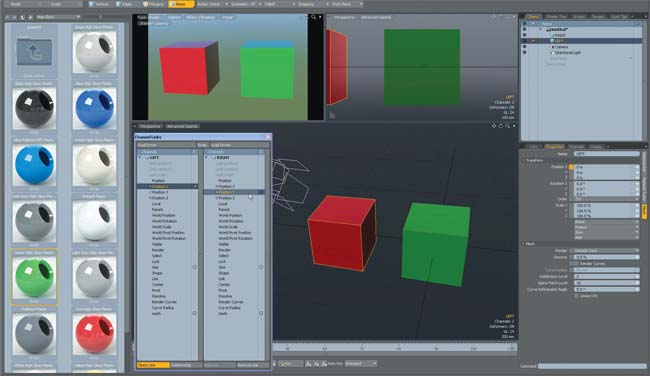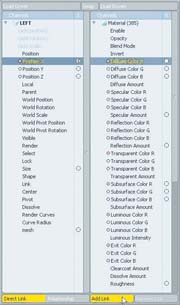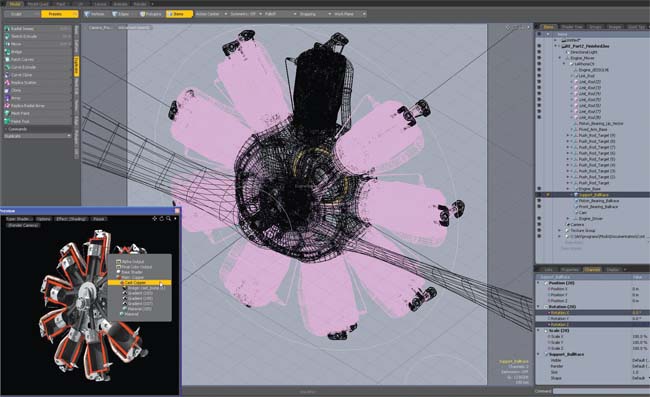Latest News
October 1, 2010
By Mark Clarkson
Luxology modo 401 is a polygon and subdivision surface modeler. It’s not at all CAD-like. That’s either good or bad, depending on who you are. Personally, I like it a lot. I reviewed modo 302 a couple years ago. I recently took a look at version 401 to see what’s changed.
 modo 401’s preset browser is much improved. The real-time preview window lets you navigate textures in your scene. |
So, What’s New?
As expected, 401 comes with quite a few handy new tools and options. There are big, splashy additions such as replicators, which allow you to populate your scenes with vast numbers of objects, and volumetric lights for creating cool 3D light and shadow effects, not to mention fur and hair.
And there are the small additions, things that just make doing what you already do a little bit easier. Background constraints have been expanded, making it easier to create new geometry that conforms to existing geometry. The pen tool has news settings to speed the creation of walls. As someone who occasionally does architectural modeling, that’s something that I appreciate, as are all the new bevel and end cap presets. Drag-weld—which lets you drag vertices together and automatically weld them—is one of my favorite new time savers, as is Grow Quads, which quickly creates new geometry around the edges.
These little improvements may only save you a click or two, but they save those clicks dozens—or hundreds—of times per modeling session. It really adds up.
Kinematics, Relationships and Constraints
modo’s biggest strides have been in its animation. In my previous review, I pronounced modo’s animation adequate for turntable spins and opening and closing a cell phone. It’s come a long way since then.
 Setting up a simple relationship in modo. The first object’s X position will drive the second object’s Y position. As the red box moves right, the green box will go up. |
modo now supports 2D planar inverse kinematics (IK) setups. With IK, long chains of linked objects can be driven by a single goal. Think of a robot arm reaching for a tool. Rather than manually setting the angle of each joint to place the hand in the right location, you attach a goal to the tool. modo’s IK automatically and continuously computes the correct angles for all the joints, so that the hand ends up where it’s supposed to be.
 You can drive any channel from any other channel. Here, the X position of one object will drive the red component of another object’s texture. |
IK in modo is currently limited to 2D planes. You can’t create an IK chain with a rotating ball joint, for example. Nor does modo support bones, needed by character animators to control organic objects. But what it does do, it does in a very robust way.
In addition to IK, 401 adds an array of linkages, constraints and relationships. You can constrain an object to travel along a path, or stick to the surface of another object. You can link objects together in ways both expected (A goes up when B goes up) and unexpected (A turns red when B goes up.)
You can drive nearly anything from nearly anything else. An object’s position and orientation, for example, can drive another object’s texture, or vice versa. You can make a phone’s LCD screen light up when the phone is flipped open by building a relationship between the rotation of the phone and the luminosity of the screen material. You can turn a car’s headlights on and off depending on the position of the physical sun, and extinguish the dome light when the doors are closed. Relationships are easy to set up, and can include math and graphs that can be tweaked to further refine interactions.
In its simplest form, you might use a direction constraint to keep your camera looking at an object (its target), but you can create setups of arbitrary complexity. Luxology has shown a demo of a fully-rigged WWII era tank with 10,000+ linkages (watch it at vimeo.com/5219591), and offers a video tutorial on setting up a radial engine complete with working pistons and cam-driven valves—all controlled by a single object that can be animated.
Presets in Plain Sight
In previous versions, presets and textures were all but hidden. Thankfully, 401 makes them much easier to get at and use. It is now easy to browse through materials, meshes, environments and assemblies and add them to your scene by double clicking or dragging and dropping.
The results of drag-and-drop materials are much more predictable than with previous versions. You can take a “blank” model and fill it in with real world textures and materials in record time.
modo’s new, faster real-time preview renderer works hand-in-glove with the texturing process. It updates continuously to let you know what your rendered textures will look like. Right clicking on any object in the preview gives you a complete breakdown of its texture. If the shader tree is open, modo it will also select the material there.
 A radial engine complete with working pistons and cam-driven valves—all controlled by a single “animatable” object. (Video tutorial available from Luxology.) |
401 comes with more presets than ever, and modo’s active user community creates more assets every day. Luxology sells special preset libraries as well (see “Presets Kits” sidebar).
Presets Kits I took at look at Luxology’s HDRE Urban and Landscape kits. These are both designed to give you a selection of completely set up outdoor environments. Double-click an environment and you get an HDRI background, as well as high-resolution background plates. The camera is set up at the correct distance, angle, and lens settings. The physical sun is at the right place in the sky. You’ve got a shadow catcher ready to go. Drop in your mesh and hit render. Luxology also offers a studio lighting kit that emulates real-world lights and materials to easily create renderings with that “studio look.” The lights even look like their real-world analogs, complete with tripods and other rigging. I also took a look at Luxology’s Product and Automotive Design Presets Pack, an impressive collection of 350 material presets ranging for the simple (black matte) to the complex (textured fur carpet and metalflake paint). I had a lot of fun customizing cars with this. |
Replicators and Fur
401 has a nifty new tool called the Replicator. Replicas are similar to the instances that modo has always had. An instance of an object has no editable geometry of its own. It’s just a copy, a doppelganger. So it is with a replica. But while instances can be moved and spun around, replicas stay where they are created.
The Replicator creates a number of replicas of a base object. The number of copies can be quite high, so you can populate a park with blades of grass or a tree with leaves. You can make replicas in rectangular and radial arrays, cloned along curves, or scattered at random. You can also manually create a point cloud to guide the replicator, placing replicas of a single rivet across an entire airplane wing, for example.
A closely related new feature is modo’s new Fur system, with all the basic tools to create hair, fur, bristles and grass. You can comb, stretch and curl the fur, and texture it using all of modo’s texturing tools. While most of us don’t model hairy objects very often, fur is still handy for creating toothbrush bristles or carpet nap.
SolidWorks Buddies
Luxology has been catering to the SolidWorks crowd lately. Its PhotoView 360 visualization and rendering software comes bundled with some versions of SolidWorks. And now, Modo 401 opens SolidWorks parts directly. This capability is a real boon to SolidWorks users, but it comes with a serious gotcha.
For some reason, SolidWorks import is only supported by the 32-bit version of the software, not in the 64-bit version. I spent quite a bit of time trying to open SolidWorks files in modo before finally figuring this out. That’s really too bad. I imagine SolidWorks users being the most likely to be using the 64-bit version of the software. The workaround is apparently to install both versions of modo and use the 32-bit version to open and re-save your SolidWorks files. This treats the 32-bit modo software as a stand-alone file translator and rather defeats the purpose of the feature. I hope it’s addressed in upcoming versions.
Assemblies do not come in with their SolidWorks links and constraints. If you want to animate them in modo, you’ll have to set them up again.
All that said, it’s still easier than ever to bring your SolidWorks projects into modo for a bit of photorealistic rendering and animation.
The Verdict
All-in-all, I like modo a lot. In fact, it’s my modeler of choice, at the moment. Yes, sometimes it makes me quite cross with its disorganized help system, periodic crashes, and elements that don’t update as and when they should.
And, as someone whose computer has two cores but whose video card has hundreds, I’m anxiously waiting for modo to jump on the bandwagon and better leverage all the computing power of my GPUs.
But it’s a fun piece of software capable of some truly impressive output. I give it a thumbs up, but you can grab a free trial version and see for yourself.
More Info:
Luxology
Contributing Editor Mark Clarkson is DE’s expert in visualization, computer animation, and graphics. His newest book is “Photoshop Elements by Example.” Visit him on the web at markclarkson.com or send e-mail about this article to [email protected].
Subscribe to our FREE magazine, FREE email newsletters or both!
Latest News
About the Author
Mark ClarksonContributing Editor Mark Clarkson is Digital Engineering’s expert in visualization, computer animation, and graphics. His newest book is Photoshop Elements by Example. Visit him on the web at MarkClarkson.com or send e-mail about this article to [email protected].
Follow DE





